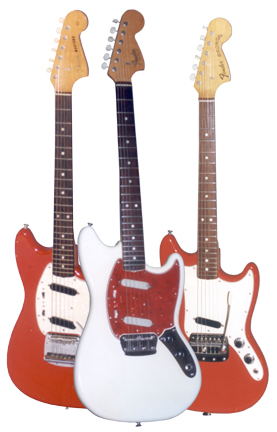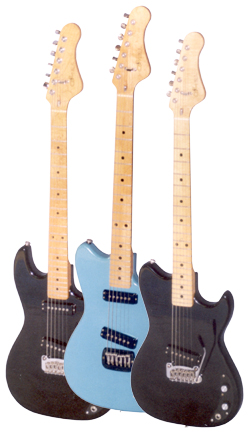STUDENT MODEL GUITARS
Copyright 2000, 20th Century Guitar Magazine.
| A good example of Leo versus Leo are his student
model guitars. Specifically, let's look at the mid-60s Fender Mustang, Duo-Sonic
II, and Bronco as well as the early '80s G&L SC-1 and SC-2.
The Mustang/Duo-Sonic II were introduced in 1964 as part of a revised student model line-up for Fender. The two guitars were essentially the same with the exception of the tailpiece: Dynamic Vibrato for the Mustang; 3-saddle hardtail bridge for the Duo-Sonic II. The bodies were generally made of alder and were downsized and slightly "melted" versions of the Stratocaster shape. The bodies did not have a back contour. The 24-inch scale maple necks were fitted with a rosewood fingerboard. Pickups were alnico magnet single coil and controls consisted master tone, master volume, and selector switches for each pickup. For more details, refer to Tim Pershing's definitive articles in the December 1996 and January 1997 issues of TCG. Introduced in 1982, the SC-2 was Leo's modern version of the Mustang/Duo-Sonic II. Like its predecessors, it filled the role of "student model" in the G&L catalog. The SC-2 was available with a Dual Fulcrum vibrato or Saddle-Lock hardtail bridge. The body was made of maple which is an unusual choice (though Rickenbacker, another SoCal guitar maker, uses it quite effectively). The earliest versions from 1982 -83 had a very Mustang-like body shape, but that was changed on the later models to a small, but Strat-like shape. Neither body style had a contour back. The fretted maple necks had a full 25.5-inch scale length. Pickups were Leo's sizzling hot soapbar "Magnetic Field Design" single coil units. These pickups eventually found their way to the ever-popular ASAT model which is still currently in production. Controls were simple - master volume, master tone and a 3-way
pickup selector switch. The Bronco shares the same body (though with different cavity routes) and 24-inch scale neck with the Mustang, but has a single pickup in the bridge position. It also sports a different vibrato tailpiece - one that was designed specifically for the Bronco. At first glance the bridge looks quite cheesy, but when set up properly it works better than Mustang's Dynamic Vibrato unit. The Bronco's design obviously stayed in Leo's head because it is reflected in the G&L SC-1. This model is essentially an SC-2 without the neck pickup. All other parts and hardware are the same. Like the SC-2, it was available as a hardtail or with a vibrato tail, the latter being fairly rare. In fact, the SC-1 and SC-2 models are rather uncommon with production totaling only several hundred units. That's a drop in the bucket compared to the thousands of Mustangs made by Fender. Now for the sonic showdown. Without doubt, the Fender student models sound typically "Fendery". The alnico pickups are not particularly hot, but the tone is sweet with a slightly compressed sound. The Mustang and Duo-Sonic II will produce some rather rubbery "in-between" tones thanks to the fancy switchgear. Despite having single coil pickup in the bridge-only position, the Bronco sounds surprisingly good and is far more versatile than one would believe. The G&Ls, on the other hand, have Leo's sizzling hot ceramic "Magnetic Field Design" single coil pickups. These sound a bit "hard" compared to most alnico pickups, but the tone is still harmonically rich. The SC-2 and SC-1, therefore, sound more modern. The SC-2, a favorite of Devo guitarist Bob Mothersbaugh, is essentially a small version of G&L's ASAT model and, not surprisingly, sounds very similar. The G&Ls have more twang factor, too, thanks to the pickups, maple body and fretted maple neck. So did Leo out gun himself? Yes and no. The main advantage of the Mustang, Duo-Sonic II and Bronco was their 24-inch scale (and a 22.5-inch scale was a factory option up to about 1970). This made them realistic guitars for kids or people with small hands. The pickups on these models sound quite good, too. The biggest drawback was the lower quality hardware and tuning stability. The shorter scale may be easier to play, but it's more difficult to keep the guitar in tune. Overall, the Fenders feel a little crude. Vintage, but not very refined. The build quality of the Fender student models was good until around 1966 when things went downhill fast for the student models (even more so than the pro-level Fender models). On the other hand, the G&L student models were essentially slightly downsized versions of their pro-level siblings. They had full scale lengths and used the same hardware as the more expensive G&L models. While the scale length may not have been as user friendly to a 6-year old, the pro-level appointments made them appealing to intermediate players looking for a pro-level guitar at a no-frills price. In addition, the build quality of the G&Ls remained very high and the guitars feel and play like the pro-line models. As student models, Leo's second round of budget guitars may or may not be superior to his earlier work. But to the average player, the G&Ls are far superior to the Fenders. About the author: Greg Gagliano proudly plays like a student
on his student model Fenders and G&Ls. |

|
